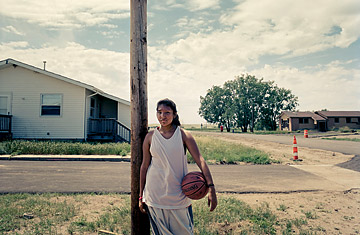
Spirit Grass, 13, is part of a family of six in Thunder Butte, S.D., who until recently survived on $3,500 a year.
(4 of 4)
Of course, solutions come in forms other than government safety nets. In Baltimore, Toemore Knight, who has been homeless, is now an electrician apprentice in a program run by the nonprofit Job Opportunities Task Force. Employers play a major role, both guiding the curriculum and providing paid on-the-job training, a "learn and earn" setup that acknowledges the infeasibility of asking cash-strapped people to front money for education. Crucially, the program also helps participants tackle other issues that reinforce poverty, like the difficulty of landing a job with a prison record and the expense of transportation. Through a partner program, Vehicles for Change, Knight is buying a used truck so that he can get to work.
Understanding what poverty is in reality--and not in myth--is crucial to any new effort to lift Americans out of it. Poverty is daunting in its complexity; it is geographically disperse, chaotic and tied to the dynamics of both a single neighborhood and the national economy. But it is surmountable. In practice, combatting it might mean opening health clinics in suburbs, restructuring college financial aid to let people enroll in just one class a semester (so it's easier for them to hold down jobs) and using the earned-income tax credit to supplement the pay of all adult low-wage workers, not just those with children. It might mean developing programs to help the poor smooth their income as well as build assets and to bolster the positive social capital that already exists in poor neighborhoods. It means paying attention to the barriers poor people actually face, and not the ones richer classes assume they do.
It may also mean being prepared to think locally. The research outfit MDRC has spent decades evaluating dozens of antipoverty programs, and as its president, Gordon Berlin, says, "We're seeing a growing body of evidence that the things that work tend to be small in scale." Whether or not a particular approach is a success often has as much to do with watchful implementation as it does a brilliant theory of change.
That doesn't mean there shouldn't be national funding or a national strategy. But the fact that there is no one archetype of the American poor means it's difficult to create a blanket policy to help them. For some, the answer is a better-paying job. For others, it's detox. For the elderly, for the disabled, for the unemployed, it's good old-fashioned social insurance.
Whatever the solution, the ambitions of the people below the line are a crucial part of it. At the Edgewood Boys & Girls Club, Sabrina Root, a divorced dental assistant who serves part time in the Army Reserve and takes community-college classes, talks about her dream of finding a career that would enable her to earn enough money to take her son to Disney World. "But I don't want people to feel sorry for me," she says. "It's not about where you come from, it's about where you're going."
